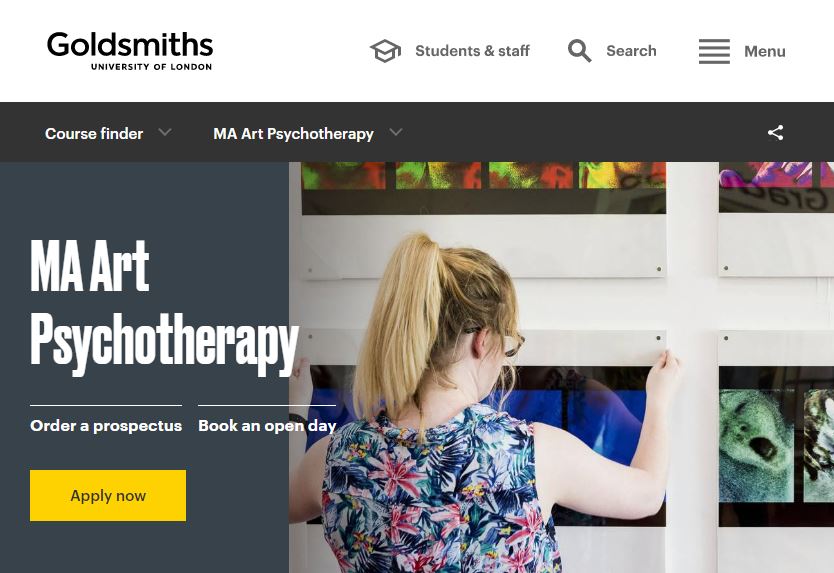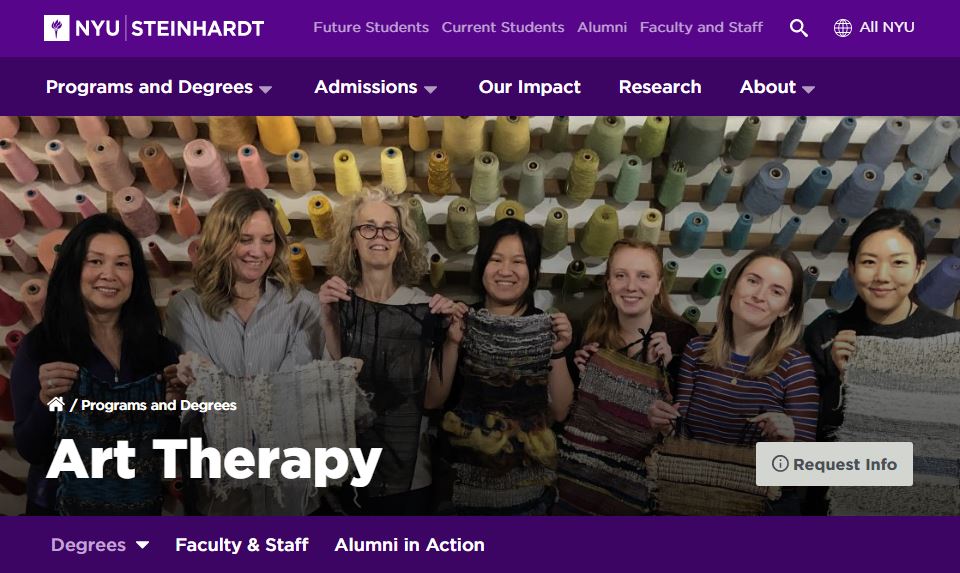[vc_row content_text_aligment=”center” simple_background_color=”#fafafa” css=”.vc_custom_1627729975505{padding-right: 20px !important;padding-left: 20px !important;}”][vc_column][vc_empty_space height=”50px”][eltdf_section_title content_alignment=”center” title_tag=”h1″ tagline_tag=”h3″ text_tag=”” title=”Art Therapist” tagline=”Job Profile” text=”Art therapists use creativity to help people with their mental health.” tagline_color=”#2dc9ff”][vc_empty_space height=”50px”][/vc_column][vc_column width=”1/2″][vc_progress_bar values=”%5B%7B%22label%22%3A%22%2435%2C000%20-%20%2445%2C000%22%2C%22value%22%3A%22100%22%2C%22color%22%3A%22sky%22%7D%5D” title=”Average Salary (per year)”][vc_empty_space height=”30px”][/vc_column][vc_column width=”1/2″][vc_progress_bar values=”%5B%7B%22label%22%3A%2237.5%20-%2040%22%2C%22value%22%3A%22100%22%2C%22color%22%3A%22sky%22%7D%5D” title=”Typical Hours (per week)”][vc_empty_space height=”30px”][/vc_column][vc_column][vc_empty_space height=”50px”][/vc_column][/vc_row][vc_row css=”.vc_custom_1627727678844{background-color: #ffffff !important;}” simple_background_color=”#ffffff”][vc_column][vc_column_text]
How to become an art therapist:
[/vc_column_text][vc_empty_space height=”30px”][eltdf_icon_list_item icon_pack=”font_elegant” fe_icon=”icon_check” title=”You will need to complete an approved post graduate qualification in art or creative therapy. Relevant undergraduate degrees include nursing, psychology, counselling and social work.”][eltdf_icon_list_item icon_pack=”font_elegant” fe_icon=”icon_check” title=”Community and volunteer positions are an excellent way to gain experience working with people with mental health issues or disabilities.”][vc_empty_space height=”50px”][vc_column_text]
Day to day activities of an art therapist:
Your day to day activities might include:[/vc_column_text][vc_empty_space height=”30px”][eltdf_icon_list_item icon_pack=”font_elegant” fe_icon=”icon_check” title=”Working with clients who have a range of challenges from disability to emotional or mental health problems to speech or language difficulties.”][eltdf_icon_list_item icon_pack=”font_elegant” fe_icon=”icon_check” title=”Visiting clients in a range of settings.”][vc_empty_space height=”50px”][vc_column_text]
Working environment of an art therapist:
Art therapists can work in a number of settings, including hospitals, schools, prisons and private clinics.[/vc_column_text][vc_empty_space height=”50px”][vc_column_text]
Professional Bodies
British association of art therapists
American Art Therapy Association[/vc_column_text][vc_empty_space height=”50px”][/vc_column][/vc_row][vc_row content_text_aligment=”left” simple_background_color=”#fafafa” css=”.vc_custom_1627729796700{padding-top: 50px !important;}”][vc_column width=”1/2″ css=”.vc_custom_1627729995849{padding-right: 20px !important;padding-left: 20px !important;}”][vc_column_text]
Skills required of an art therapist:
[/vc_column_text][vc_empty_space height=”20″][eltdf_icon_list_item icon_pack=”font_elegant” fe_icon=”icon_check” title=”Patience and understanding”][eltdf_icon_list_item icon_pack=”font_elegant” fe_icon=”icon_check” title=”Non-judgemental counselling skills”][eltdf_icon_list_item icon_pack=”font_elegant” fe_icon=”icon_check” title=”Flexibility and empathy”][eltdf_icon_list_item icon_pack=”font_elegant” fe_icon=”icon_check” title=”An ability to remain calm in stressful or difficult situations”][eltdf_icon_list_item icon_pack=”font_elegant” fe_icon=”icon_check” title=”A professional knowledge of psychology and art therapy”][vc_empty_space height=”50px”][/vc_column][vc_column width=”1/2″ css=”.vc_custom_1627729987409{padding-right: 20px !important;padding-left: 20px !important;}”][vc_column_text]
Art therapist courses:
[/vc_column_text][vc_empty_space height=”20″][vc_column_text]
 [/vc_column_text][vc_empty_space height=”50px”][/vc_column][/vc_row][vc_row css=”.vc_custom_1627727678844{background-color: #ffffff !important;}” simple_background_color=”#ffffff”][vc_column][vc_empty_space height=”50px”][vc_column_text]
[/vc_column_text][vc_empty_space height=”50px”][/vc_column][/vc_row][vc_row css=”.vc_custom_1627727678844{background-color: #ffffff !important;}” simple_background_color=”#ffffff”][vc_column][vc_empty_space height=”50px”][vc_column_text]
Meet the art therapist – Amy Jeans
[/vc_column_text][/vc_column][vc_column width=”1/2″][vc_single_image image=”6066″ img_size=”full” alignment=”center” onclick=”custom_link” img_link_target=”_blank” link=”http://www.amyjeanstherapist.com/”][vc_empty_space height=”20px”][eltdf_icon icon_pack=”font_elegant” fe_icon=”icon_desktop” size=”eltdf-icon-small” type=”eltdf-normal” icon_animation=”yes” target=”_blank” link=”http://www.amyjeanstherapist.com/”][eltdf_icon icon_pack=”font_elegant” fe_icon=”social_instagram_square” size=”eltdf-icon-small” type=”eltdf-normal” icon_animation=”yes” target=”_blank” link=”https://www.instagram.com/amyjeanstherapist/”][vc_empty_space height=”50px”][/vc_column][vc_column width=”1/2″][eltdf_accordion style=”toggle”][eltdf_accordion_tab title_tag=”h3″ title=”What made you want to become an Arts therapist?”][vc_column_text]😍 Well, I had a lot of interests that all came together. I am naturally an empath and grew up in a creative household. I am fascinated by people and have always enjoyed interaction with others. I also really like to play! After going to University I went to drama school for a while but discovered I didn’t enjoy performing. I liked the process of creating characters but hated the stage fright and feeling of exposure I got when performing. After this I worked as a support worker for children and adults with learning disabilities and as a teaching assistant in a primary school. In these settings, I found I felt quite rebellious! I wanted to question things and I became very engaged with exploring individual relationships and learning about people’s unique strengths. I often discovered a lot connecting through play and Art and wanted more time for this. I realised that a career as an Arts therapist could offer everything I was looking for.[/vc_column_text][/eltdf_accordion_tab][eltdf_accordion_tab title_tag=”h3″ title=”What was the route to become an Arts therapist?”][vc_column_text]I was 23 when I decided to train as an Arts therapist but the minimum age for acceptance on the training was 24. I continued working in schools and as a tutor for adults with learning disabilities to gain experience until I was 24 and got a place at the Central School of Speech and Drama in London. I studied full time for 1 year and then spent a further year completing a Masters in drama and movement therapy. Part of the training was to undertake supervised placements. I worked in an adult psychiatric unit, a primary school and a specialist school for children on the Autistic Spectrum. After qualification I set up my own private practice.[/vc_column_text][/eltdf_accordion_tab][eltdf_accordion_tab title_tag=”h3″ title=”Describe a typical working day”][vc_column_text]I have been working as an Arts Therapist for 20 years now and one of the things I enjoy is that there is no real typical day. I have spent periods of time employed for charities and times working in private practice too. sometimes I have combined both. For the last few years I have been running therapy services in schools. A typical working day during this time has been to arrive at school at 8.30, meet with the senior team and set up the therapy space. I see 4 children for 1 hour individual therapy sessions, with breaks in between. If there are safeguarding issues these need to be dealt with onsite and with the staff team. I offer wraparound services too so I liaise with teachers and parents about each child I see. The day ends at around 4.30 pm. I am usually pooped but quite content![/vc_column_text][/eltdf_accordion_tab][eltdf_accordion_tab title_tag=”h3″ title=”What can people do to make sure they have the skills needed?”][vc_column_text]Once you have found the training that suits you, the organisation should be able to tell you their entry requirements for training, as this may vary from course to course. Check them out and if there is anything you are lacking, you can set about gaining that experience or finding a different course that may have different entry requirements. Once accepted, a good course should prepare you with all the skills you need.[/vc_column_text][/eltdf_accordion_tab][eltdf_accordion_tab title_tag=”h3″ title=”What do you enjoy about the job?”][vc_column_text]Everything! I work with children and I love spending my working hours engaged in creative and curious play. It brings me enormous pleasure to see children use the therapy space to grow and to overcome their difficulties. The creative potential of the Arts is that it allows indirect and unconscious engagement with things children find difficult. Within the safety of the Art form and supported/guided by their therapist, children can resolve their own difficulties and increase their feelings of self esteem. Seeing children begin to feel great about themselves is the most awesome and inspiring feeling for me.
Although I am always sad to say goodbye, it is brilliant to realise that children no longer need me. They may enjoy my company but they are ready to set off alone. Usually their relationships with their families and teachers have improved to the point where everyone understands and communicates with each other better.[/vc_column_text][/eltdf_accordion_tab][eltdf_accordion_tab title_tag=”h3″ title=”What are the main challenges in this role?”][vc_column_text]Personally, it has been a real challenge to learn the art of self-care and replenishing myself. When working with traumatised children it can be hard not to feel despair, anger and helplessness at their situations. Our capacity will always be limited as we cannot change their whole worlds, only the ways they manage and interact with them. Learning to understand the significance of this has been a challenge that has got increasingly easy with time. Now, I focus on the potential of each child and what can be improved, rather than what cannot. Their internal worlds are vast and if they are comfortable with themselves and begin to learn resilience, I feel hopeful always for their futures.[/vc_column_text][/eltdf_accordion_tab][/eltdf_accordion][/vc_column][/vc_row][vc_row][vc_column][vc_empty_space height=”50″][eltdf_social_share icon_type=”font-elegant”][/vc_column][/vc_row][vc_row content_placement=”middle” css_animation=”fadeIn” simple_background_color=”#fafafa”][vc_column width=”1/2″][vc_column_text]
Like this page? Pin it!!
[/vc_column_text][/vc_column][vc_column width=”1/2″][vc_column_text] [/vc_column_text][/vc_column][/vc_row][vc_row][vc_column][eltdf_separator type=”full-width” border_style=”” color=”#9024cf” top_margin=”20″ bottom_margin=”20″ thickness=”10″][vc_column_text]
[/vc_column_text][/vc_column][/vc_row][vc_row][vc_column][eltdf_separator type=”full-width” border_style=”” color=”#9024cf” top_margin=”20″ bottom_margin=”20″ thickness=”10″][vc_column_text]
Read more…
[/vc_column_text][vc_empty_space height=”20″][vc_masonry_grid post_type=”page” max_items=”3″ grid_id=”vc_gid:1628068196017-b853e544-573e-6″ taxonomies=”104″][vc_empty_space height=”100px”][/vc_column][/vc_row]
